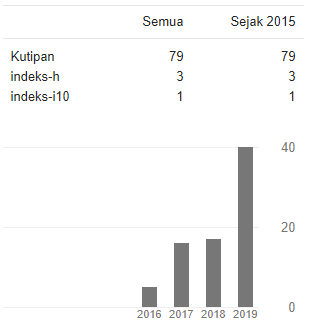DAMPAK PROGRAM PEMBINAAN KELUARGA REMAJA (BKR) TERHADAP UPAYA PENCEGAHAN STUNTING DI BALAI PENYULUHAN KB PALANGGA
DOI:
https://doi.org/10.52943/jikeperawatan.v11i1.1859Keywords:
attitude, adolescent family development program (BKR), behavior, knowledge, stuntingAbstract
Background: Stunting is an abnormal growth condition that has become one of the primary nutritional issues among toddlers in society. The Adolescent Family Development Program (Bina Keluarga Remaja or BKR) is an initiative developed by the National Population and Family Planning Agency (BKKBN) aimed at fostering family resilience and enhancing the quality of adolescents.
Purpose: This study aims to analyze the impact of the Adolescent Family Development Program (Bina Keluarga Remaja or BKR) on stunting prevention within the operational area of the Family Planning Counseling Center in South Palangga District.
Methods: This research employs a quantitative method with a pre-experimental approach, conducted from May to June 2024. The study population consists of 350 adolescents attending junior high schools (SMP) and vocational high schools (SMK) in the Amondo Village area. The sample was selected using simple random sampling, resulting in a total of 188 participants, comprising 94 junior high school students and 94 vocational high school students.
Results: The research results indicate a p-value of 0.000 for the knowledge variable, a p-value of 0.000 for the attitude variable, and a p-value of 0.000 for the action variable.
Conclusion: The Adolescent Family Development Program significantly influences adolescents' knowledge, attitudes, and actions in preventing stunting. Collaboration is essential, involving adolescents' participation, parents' skills in guiding their teenagers, school-level supervision, government policy support, and the competencies of educators and counselors in providing education and monitoring.
Downloads
References
Andi, S. F. W., Azis, Darmawansyah, Amran, R., Alwy, A., Muh, S., & Anwar, M. (2023). Analysis of Policy Implementation of The First 1000 Days of Life Program in Overcoming Stunting in Maros District. Pharmacognosy Journal, 15(3).
Black, R. E., Victora, C. G., Walker, S. P., Bhutta, Z. A., Christian, P., de Onis, M., Ezzati, M., Grantham-McGregor, S., Katz, J., Martorell, R., & Uauy, R. (2013). Maternal and child undernutrition and overweight in low-income and middle-income countries. Lancet, 382(9890), 427-451. https://doi.org/10.1016/s0140-6736(13)60937-x
Ekholuenetale, M., Barrow, A., Ekholuenetale, C. E., & Tudeme, G. (2020). Impact of stunting on early childhood cognitive development in Benin: evidence from Demographic and Health Survey. Egyptian Pediatric Association Gazette, 68, 1-11.
FH, W. M., Mu’afifah, A. N., Izza, E. N., Fadhilah, A. Z., Hanif, A., Septianti, N. L., Fanani, A. A., & Ridwan, A. (2024). Educating the Community to Prevent Stunting Through Participatory Action Research. Social Studies in Education, 2(2), 207-108.
Fitria, L., & UB, A. R. (2024). Efektivitas Program Bina Keluarga Remaja (BKR) dalam Meminimalisir Terjadinya Pernikahan Dini di Kabupaten Sidoarjo. Ranah Research: Journal of Multidisciplinary Research and Development, 6(5), 1684-1697.
Gau, B. A. M. T., & Metiyanti, M. (2024). Pembinaan kesehatan reproduksi dan gizi bagi anggota keluarga remaja di kampung KB Balabatu, Kecamatan Buntao’ Sulawesi Selatan, Indonesia. Tongkonan: Jurnal Pengabdian Masyarakat, 3(1), 1-6.
Hanum, F. (2024). Efektivitas program bina keluarga balita dalam pencegahan stunting di kampung keluarga berkualitas Nagari Rambatan Kecamatan Rambatan kabupaten tanah datar Provinsi Sumatera Barat IPDN].
Hidayah, N., Rita, W., Anita, B., Podesta, F., Ardiansyah, S., Subeqi, A. T., Nasution, S. L., & Riastuti, F. (2019). Hubungan pola asuh dengan kejadian stunting (rekomendasi pengendaliannya di Kabupaten Lebong). Riset Informasi Kesehatan, 8(2), 140-151.
Humphrey, J. H. (2009). Child undernutrition, tropical enteropathy, toilets, and handwashing. The Lancet, 374(9694), 1032-1035. https://doi.org/10.1016/S0140-6736(09)60950-8
Kagure, M. (2022). Determinants of Stunting Among Children Aged 6-23 Months in Rural Arid and Semi-arid (Asal) Counties in Kenya University of Nairobi].
Kementrian Kesehatan Republik Indonesia (Kemenkes). (2023). https://www.badankebijakan.kemkes.go.id/hasil-ski-2023/
Lestari, E., Siregar, A., Hidayat, A. K., & Yusuf, A. A. (2024). Stunting and its association with education and cognitive outcomes in adulthood: A longitudinal study in Indonesia. Plos one, 19(5), e0295380.
Liem, S., Marta, R. F., & Panggabean, H. (2019). Sanitation behavior and risk of stunting: Understanding the discourse of a public service announcement. Jurnal The Messenger, 11(2), 168-181.
Marlinawati, D. A., Rahfiludin, M. Z., & Mustofa, S. B. (2023). Education Media about Stunting Prevention on Adolescents in Islamic Boarding Schools. Journal of Educational, Health & Community Psychology (JEHCP), 12(3).
Mertens, A., Benjamin-Chung, J., & Colford, et. al. (2023). Child wasting and concurrent stunting in low- and middle-income countries. Nature, 621(7979), 558-567. https://doi.org/10.1038/s41586-023-06480-z
Our World in Data. (2024). Half of all child deaths are linked to malnutrition. https://ourworldindata.org/half-child-deaths-linked-malnutrition?#article-citation
Prendergast, A. J., & Humphrey, J. H. (2014). The stunting syndrome in developing countries. Paediatrics and international child health, 34(4), 250-265.
Selmi, M. L. A., & Rusman, A. D. P. (2021). Efektvitas pelaksanaan program bina keluarga remaja (BKR) pada dinas pengendalian penduduk dan keluarga berencana di Kota Parepare. Jurnal Ilmiah Manusia Dan Kesehatan, 4(1), 10-23.
Setiawan, A. S., Budiarto, A., & Indriyanti, R. (2023). Eating behavior of adolescent girls in countries with a high prevalence of stunting under five: a systematic review. Frontiers in Psychology, 14, 1228413.
Soviyati, E., Sulaeman, E. S., Sugihardjo, I., & Wiboworini, B. (2023). Effect of applying the health promotion model in stunting prevention and behavior control in Indonesia. Journal of education and health promotion, 12(1), 227.
Wansink, B. (2015). Change Their Choice! Changing Behavior Using the CAN Approach and Activism Research. Psychology & Marketing, 32. https://doi.org/10.1002/mar.20794
Widaryanti, R., Thomas, A. A. E., & Indrawati, F. L. (2023). Hambatan dan peluang pencegahan stunting dengan melibatkan remaja: studi kualitatif di kota yogyakarta. Jurnal Formil (Forum Ilmiah) Kesmas Respati,
Widyahening, I. S., Aufa, M. A., Alhas, M. F., Widodo, A. B., & Friska, D. (2021). Knowledge, Attitude, and Practice of Mothers on the First 1000 Days of Life. eJournal Kedokteran Indonesia, 9(2), 129. https://doi.org/10.23886/ejki.9.65.129
Woldehanna, T., Behrman, J. R., & Araya, M. W. (2017). The effect of early childhood stunting on children’s cognitive achievements: Evidence from young lives Ethiopia. Ethiopian Journal of Health Development, 31(2), 75-84.
World Bank Group. (2024). The world bank and nutrition. https://www.worldbank.org/en/topic/nutrition
World Health Orgaization. (2023). Joint child malnutrition estimates. Retrieved January, 06 from https://www.who.int/data/gho/data/themes/topics/joint-child-malnutrition-estimates-unicef-who-wb?
Yorita, E., Nugraheni, D. E., Yanniarti, S., Savitri, W., & Dewi, R. (2023). Pemberdayaan kader sebagai upaya meningkatkan pengetahuan dan sikap kelompok bina keluarga remaja tentang pendewasaan usia perkawinan. JMM (Jurnal Masyarakat Mandiri), 7(6), 5454-5464.
Downloads
Published
How to Cite
Issue
Section
License
Copyright (c) 2025 Jurnal Ilmiah Keperawatan IMELDA

This work is licensed under a Creative Commons Attribution-NonCommercial 4.0 International License.








